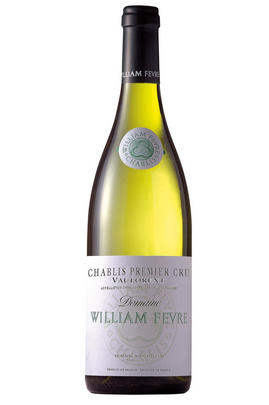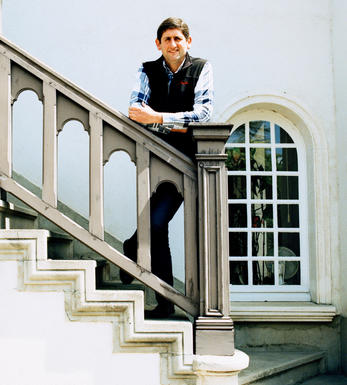
2016 Chablis, Vaulorent, 1er Cru, Domaine William Fèvre, Burgundy

Critics reviews
Pale colour with a light green reflection, backward and quite classy. Smoothly attractive but rather soft and the oak is a bit too present at the moment, though I think this will integrate better later on. DIAM 10 closure
Jasper Morris MW, Inside Burgundy (May 2019)
An expressive, and once again mildly exotic, nose is comprised by notes of oyster shell, iodine and strong mineral reduction. The concentrated, mouth coating and serious flavors are at once muscular yet refined, all wrapped in a long, agreeably dry and balanced finish.
Drink 2022+
Burghound.com (Oct 2018)
The 2016 Chablis Vaulorent 1er Cru has a really lovely bouquet with dried pineapple, musk, chalk dust and yellow flower aromas. The palate is well balanced with a smooth entry, nicely pitched acidity with a gorgeous yellow plum, orange rind and light strawberry finish that lingers in the mouth. Excellent.
Drink 2020 - 2032
Neal Martin, vinous.com (Aug 2018)
Tangy and rich, but without the same definition as their Montée de Tonnerre. Full bodied, and while the acid is certainly present, the palate is fat overall. A good demonstration of the fuller side of Chablis. Attractive flinty notes on the finish.
Drink 2018 - 2028
Richar Hemming MW, jancisrobinson.com (Jan 2018)
Vaulorent is one of the finest premiers crus in Chablis, and Fèvre own 3.5 hectares here. The 2016 rendition is superb, revealing a classic bouquet of citrus, white peach, wet stones and spring flowers. The palate is elegantly glossy on the attack, with a deep core, lovely dimension and a long, flavourful finish. This is the pick of the litter among Fèvre’s premier crus.
Drink 2019 - 2027
William Kelley, Decanter.com (Oct 2017)
(All of William Fèvre's vines in Fourchaume are situated in Vaulorent, where they're the largest land owner; there's usually a separate estate bottling labeled as Fourchaume but not in 2016): Pale green-tinged yellow. Musky, complex aromas of citrus fruits, spices, minerals and pepper. Ripe fruit notes are joined by a hint of exotic lichee, but the wine's pliant texture is nicely supported by pepper, spices and minerals. This fairly large-scaled, savory wine boasts an exhilarating balance of sweetness and acidity. Finishes with explosive length and a strong impression of terroir. The crop level here was just 18 hectoliters per hectare and my notes say that this wine is at the same high level of quality as the Montée de Tonnerre.
Stephen Tanzer, vinous.com (Aug 2017)
About this WINE

Domaine William Fevre, Chablis
William Fèvre is one of Chablis’ greatest wine domaines, developed by the eponymous William Fèvre between 1957 and his retirement in 1998 when he sold to the Champagne House Joseph Henriot. William Fèvre began with just 7 hectares and had soon increased this to 48ha, planting widely in the best of the 1ers and grands crus where the vineyards had fallen by the wayside. However the Fèvre penchant for new oak was not to everybody’s taste.
Since the Henriot purchase the wines are made by the talented Didier Séguier who had previously been with the Bouchard team in Beaune. The domaine wines include 12 hectares of premier cru vineyards and no less than 16 hectares of grand crus.The whole crop of their domaine wines, straight Chablis included, is harvested by hand, the grands crus in small ‘cagettes’, with a sorting table back at the winery to ensure the quality of the raw material.
The 1er cru wines are vinified in 40-50% oak, the grands crus receiving 70-80%, but without using new wood – instead the domaine receives a plentiful supply of one year old barrels from Maison Bouchard, and the average age of wood in the cellars is 5 years old. The barrel and vat components are blended together after four to six months, for bottling before the end of the year.
In 1991 he joined forces with the Chilean producer Victor Pino and Vina William Fèvre was established in the heart of the Maipo Valley just outside Santiago.

Chablis
Chablis lies further north than the rest of Burgundy, located about halfway between Beaune and Paris; it’s actually not all that far from Champagne. The wines here – exclusively whites from Chardonnay – differ in style from other white Burgundies: they tend towards steeliness and flintiness.
The Chablis region is an island of vines lying amid the forests and pastures of the Yonne département. In the heart of Chablis, the soils are marl (clay-limestone) of a particular kind – Kimmeridgian – containing traces of marine fossils. For many, the classic aroma and flavour profile of Chablis is built around seashell and an iodine, marine character imparted by the soil.
As elsewhere in Burgundy, there’s a hierarchy in Chablis. Grand Cru represents the top tier, although it accounts for just one per cent of overall Chablis production. The Grand Cru vineyards rise above the eponymous town in an impressive sweep, sloping south. These are sunny sites, ranging in elevation from 100 to 250 metres above sea level. The wines are deep and powerful, benefitting hugely from bottle age after release. The best examples can age for up to 20 years. Over time, their colour evolves from greenish gold to a light yellow, and they develop real aromatic complexity.
Unlike the other tiers, it’s not uncommon for Grand Cru Chablis to see new oak. As a result, its flavour profile is perhaps more comparable to the Côte d’Or than the rest of Chablis. For something more classically “Chablis”, there’s the Premiers Crus. Style and quality can vary, depending on the climat and the producer. Whether floral or more mineral, the best examples are seriously impressive and represent the hallmark style of the region – they can also offer real value for money. These are structured wines with the capacity to age for 10 to 15 years.
The next tier – accounting for most of the region’s output – is labelled simply as “Chablis”. These are steely, clean and lean whites with aromas of green apples and lemon, intended for early drinking. As ever in Burgundy, there are exceptions: well-made examples by top growers from vineyards abutting the Premiers Crus can be age-worthy.
Finally, there’s Petit Chablis: everyday wines, generally from vineyards planted on higher slopes. Petit Chablis accounts for around one-fifth of all Chablis produced. These wines typically come from Portlandian limestone, known to produce a fruitier, simpler wine than Chablis.

Chardonnay
Chardonnay is often seen as the king of white wine grapes and one of the most widely planted in the world It is suited to a wide variety of soils, though it excels in soils with a high limestone content as found in Champagne, Chablis, and the Côte D`Or.
Burgundy is Chardonnay's spiritual home and the best White Burgundies are dry, rich, honeyed wines with marvellous poise, elegance and balance. They are unquestionably the finest dry white wines in the world. Chardonnay plays a crucial role in the Champagne blend, providing structure and finesse, and is the sole grape in Blanc de Blancs.
It is quantitatively important in California and Australia, is widely planted in Chile and South Africa, and is the second most widely planted grape in New Zealand. In warm climates Chardonnay has a tendency to develop very high sugar levels during the final stages of ripening and this can occur at the expense of acidity. Late picking is a common problem and can result in blowsy and flabby wines that lack structure and definition.
Recently in the New World, we have seen a move towards more elegant, better- balanced and less oak-driven Chardonnays, and this is to be welcomed.


Buying options
Add to wishlist
Description
The nose has toasted, grilled notes which owe more to the marl soils than any oak ageing. As one would expect from the only Premier Cru on the Grand Cru hill, this is rich and seductive, with a cashmere texture. Excellent acidity; this is an iron fist in a velvet glove, with Grand Cru power and structure. Drink 2021-2026.
Adam Bruntlett, Senior Buyer, Berry Bros. & Rudd
wine at a glance
Delivery and quality guarantee